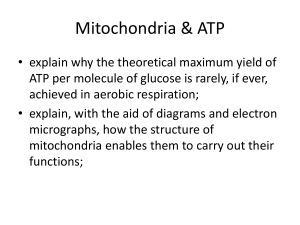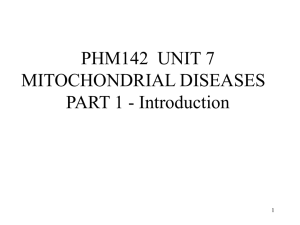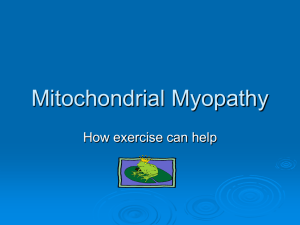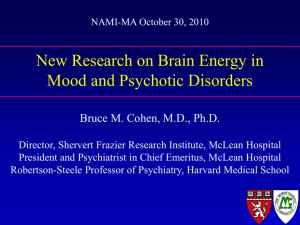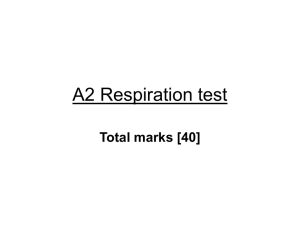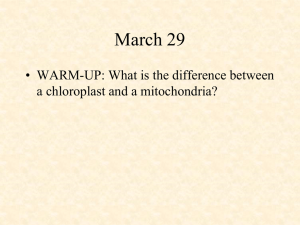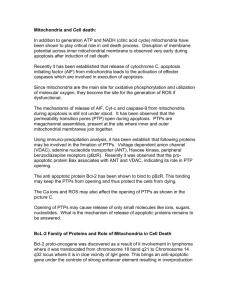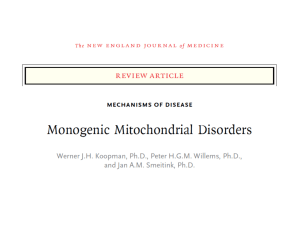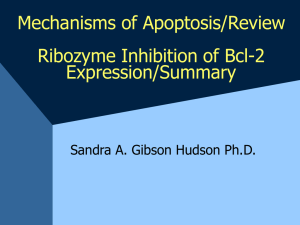Mitochondrial DNA replication
advertisement
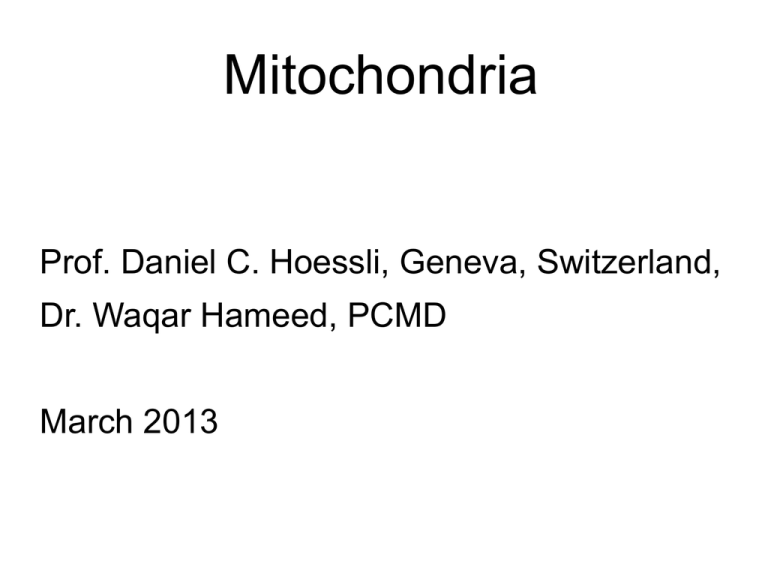
Mitochondria Prof. Daniel C. Hoessli, Geneva, Switzerland, Dr. Waqar Hameed, PCMD March 2013 Figure 14-4 Essential Cell Biology (© Garland Science 2010) Figure 14-3 Essential Cell Biology (© Garland Science 2010) Mitochondria: where do they come from ? Mitochondria probably originate from archeobacteria that were engulfed by a phagocytic cell. The two have lived in symbiosis ever since. Then what has the bacterium brought in that is beneficial to the host cell ? The capacity to transport electrons and make a proton gradient across the membrane How do mitochondria and host cells share resources ? Mitochondria have their own DNA and express their genes to produce proteins active in the electron transport chain. However, most of the proteins they need are encoded in the nucleus of the cell. They need to import most of their proteins to function. Mitochondrial division and segregation Molecular Biology of the Cell. 4th edition. Alberts B, Johnson A, Lewis J, et al Mitochondrial genome: evolutional influence Overview of mitochondrial gene expression Mitochondrial genome http://zhangzhiyi.weibin.me/2012/10/31/mitochondrial-and-plastids-dna/ Mitochondrial genome: human Vs yeast http://www.cbs.dtu.dk/staff/dave/roanoke/genetics44.html Mitochondrial DNA replication fork: critical proteins required for DNA replication Copeland W. C. et al., 2012 Mitochondrial DNA replication Copeland W. C. et al., 2012 Mitochondrial DNA transcription initiation machinery and promoters Mitochondrial transcription: Lessons from mouse Gene Regulatory Mechanisms Volume 1819, Issues 9?10 2012 961 - 969 http://dx.doi.org/10.1016/j.bbagrm.2011.11.001 Mitochondria have a specific genetic code Alterations in the Standard Genetic Code in Mitochondria Codon Standard Code: NuclearEncoded Proteins Mitochondria Mammals Drosophil a Neurospora Yeasts Plants UGA Stop Trp Trp Trp Trp Stop AGA, AGG Arg Stop Ser Arg Arg Arg AUA Ile Met Met Ile Met Ile AUU Ile Met Met Met Met Ile UUU, CUG, CUA, CUG Leu Leu Leu Leu Thr Leu Biogenesis of mitochondrial proteins Pfanner et al., 2009 Mitochondrial targeting and sorting signals Pathways of protein import into mitochondria Two models for unfolding and translocation of preproteins across the mitochondrial membranes Neupert W. and Brunner M. (2002) The translocase of the inner mitochondrial membrane for presequence-carrying preproteins Import of a hydrophobic carrier protein into the inner mitochondrial membrane The mitochondrion Is the site of the citric acid cycle, where the substrates NADH and FADH2 donate electrons to the inner mitochondrial membrane electron transport chain. The result of electron transport is to build up a gradient of H+ protons outside the inner mitochondrial membrane (IMM) The accumulated H+ protons traverse the IMM back to the matrix and in so doing, activate the membrane ATP synthase and generate 80% of the cellular ATP Oxidative phosphorylations Oxidative phosphoryations are a chemiosmotic process whereby high energy electrons of NADH are converted into high energy phosphate bonds of ATP Oxidative phosphorylations do not need O2 to produce ATP. O2 is actually combined with the electrons at the end of the transport chain to produce water. Figure 14-8 Essential Cell Biology (© Garland Science 2010) The majority of ATP molecules are produced in the inner mitochondrial membranes Mitochondrial membranes contain highly specialized proteins that: Transport electrons from one protein to another, Thus providing energy to pump H+ protons from one side of the membrane to the other, and Allow the ATP synthase transmembrane protein to produce ATP The key bioenergetic molecules The electron and proton transporters: NADH FADH2 and the final products: ATP Figure 14-5 Essential Cell Biology (© Garland Science 2010) Figure 14-7 Essential Cell Biology (© Garland Science 2010) Figure 14-11 Essential Cell Biology (© Garland Science 2010) Figure 14-20 Essential Cell Biology (© Garland Science 2010) Figure 14-14 Essential Cell Biology (© Garland Science 2010) Figure 14-9 Essential Cell Biology (© Garland Science 2010) Ubiquinone Cytochrome c Horse Cytochrome c Stevens. Metallomics, 3:319 (2011) Figure 14-6 Essential Cell Biology (© Garland Science 2010) The cytochome oxidase: the 3rd complex in the electron transport chain Figure 14-22 Essential Cell Biology (© Garland Science 2010) The ATP synthase machine Figure 14-12 Essential Cell Biology (© Garland Science 2010) The last (and most important steps) of cellular energy production occur in mitochondria The mitochondrion Maintains cellular homeostasis of energy levels (ATP), Ca and of reactive oxygen species (ROS). The electron transport chain produces most of the ROS present in the cell Cytochrome c is capable of both sensing the ATP-ADP levels and decreasing the level of ROS The other side of mitochondria: apoptosis regulation Mitochondria not only sustain life by producing ATP, they also control the health of the cell and may induce it to die in the controlled manner of apoptosis, without causing inflammatory damages. Apoptosis is therefore called: programmed cell death Apoptosis Through the release of Cytochrome c, the mitochondrion controls (induces or prevents) most decisions to undergo programmed cell death by the cell: this implies both mostly the intrinsic and to a lesser extent the extrinsic pathways of apoptosis Modalities of cell death necrosis apoptosis phagocytosis Nature reviews Mol.Cell Biol. 9; 2008 The Cytochrome c Is evolutionarily a conserved, nuclear-encoded and highly charged (pI 9.6) mitochondrial protein of 104 aa. Contains a heme group covalently bound to cysteines 14 and 17 via thioether bonds. The heme iron is in a hexacoordinate configuration with histidine 18 and methionine 80 and lies in a very hydrophobic environment Is a multifunctional enzyme involved in: electron transfer, apoptosome formation, cardiolipin peroxidation and which contains 4 phosphorylation sites (Y97, Y48, T28 and S/T 47) The Cytochrome c Contains 4 phosphorylatable residues (Y97, Y48, T28 and S/T47) that can be modified following yet to be defined extracellular signals. Contains an ATP binding site (Glu69, Asn 70, Lys88 and Lys72, Lys86, Lys87) and may slow down ATP production when the site is occupied. A phospholipid-binding site interacts with cardiolipin, the membrane lipid that attaches Cytc to the membrane, and specific Lys (39, 25 and 7) are involved in contacting Apaf-1. Nature reviews Mol.Cell Biol. 9; 2008 The many functions of cytochrome c Hütteman et al. Mitochondrion 11, 369 (2011 Critical amino acid residues in Cytochrome c Hütteman et al. Mitochondrion 11, 369 (2011 Hüttemann et al. 2011. Mitochondrion vol 11 Unifying hypothesis for mitochondrial function Phosphorylation of Cytc (Y48 and Y97) ensures controlled ATP production, without excessive ROS generation. Dephosphorylation of Cytc will cause: Increased oxidative phosphorylations, with increased membrane mitochondrial potential (Δψm) and increased ROS production Release of Cytc from the IMM (inner mitochondrial membrane) following oxidation of cardiolipin. A dephosphorylated Cytc is necessary for apoptosome formation and activate caspases. Which are the cytoplasmic proteins that impact on mitochondria and control apoptosis ? The Bcl-2 family of proteins, which may be pro- or anti-apoptotic The Ras small GTPases, which may enhance or decrease the action of Bcl-2 proteins Bcl-2 family of proteins The major role of Bcl-2 family of proteins is to control the mitochondrial outer membrane permeability (MOMP). MOMP controls the release into the cytoplasm of proteins contained in the mitochondrial intermembrane space, including cytochrome c. Cytochrome c, when in the cytoplasm, interacts with Apaf-1 and leads to the assembly of the apoptosome to carry out apoptosis Developmental Cell 21, 2011 Groups of Bcl-2 proteins The anti-apoptotic proteins (Bcl-2, Bcl-XL; Bcl-w; Mcl-1 and A1/Bfl-1) display the BH1, BH2, BH3 and BH4 domains, and a transmembrane domain ™. The pro-apoptotic proteins (Bax; Bak and Bok/Mtd) also display BH1 to BH4 domains and TM domain. The BH3-only proteins (Bid, Bim/Bod, Bad, Bmf, Bik/Nbk, Blk, Noxa, Puma/Bbc3 and Hrk/DP5) lack TM domains and thus directly interact with anti- or proapoptotic Bcl-2 family proteins Bad (BH3-only protein) sequesters Bcl-2 (an anti-apoptotic protein) in cells responding to apoptotic stimuli. When the Akt kinase phosphorylates Bad, Bcl-2 is released and its anti-apoptotic potential restored. Interaction of pro-apoptotic Bax with anti-apoptotic Bcl-xL: Bax-Bcl-xL complexes shuttle from the cytoplasm to the OMM, thus preventing accumulation of Bax in the OMM, oligomerization of Bax and permeabilization of the OMM (MOMP), and consequently release of cytochrome c Dev. Cell 2011, 21:92-101 The BH3-only proteins The BH3-only proteins interact with anti-apoptotic proteins (i.e. Bad with Bcl-2 or Bcl-xL) and allow Bax-Bak oligomerization in the mitochondial membrane, followed by cytochrome C release and apoptosis. The BH3-only proteins have little in common among themselves, aside the BH3 domain. They act as sensors for cellular stress, cell damage, infection, growth factor deprivation, and any other signal that causes apoptosis. Activation of BH3-only proteins occurs by a variety of means such as transcriptional up-regulation, limited proteolysis or dephosphorylation. Mol. Cell. 36; 2009 Other cytoplasmic small GTPases can influence Bcl-2 proteins Ras proteins constitute a very large family of small GTPases that can influence the function of Bcl-2 proteins in either promoting or inhibiting their action. Intracellular switches Mitochondrial dynamics Highly connected mitochondria support a higher level of ATP production. For instance, starved cells tend to increase the size of their mitochondrial networks and cells undergoing apoptosis fragment their mitochondrial networks. Fusion and fission of mitochondria is carried out by mitofusins (fusion) and Drp1 (fission), proteins, which are dynamin-related GTPases. Mol. Cell. 36; 2009 Do mitochondria function differently in cancer cells ? The metabolic phenotype of cancer cells is the consequence of a remodeling of mitochondria, resulting in: 1) suppressed oxidative phosphorylations, 2) enhanced glycolysis 3) suppressed apoptosis Mitochondria in cancer cells In the initial stages of tumor growth, cancer cells live in relative hypoxic conditions, which favors glycolytic degradation of glucose for energy production. This indeed promotes an acidic cytoplasmic pH (lactate accumulation) which suppresses apoptosis, but also facilitates extracellular matrix breakdown, cell motility and invasion. Mitochondria in cancer cells It was considered earlier that the „glycolytic“ phenotype of cancer cells was the consequence (due to damaged mitochondria), rather than the cause of cancer. It is now believed that the bioenergetic cancer defect of mitochondria is not permanent, but reversible, and could be targeted in cancer treatment. How to modify the metabolic phenotype of cancer cell mitochondria ? The enzyme pyruvate dehydrogenase (PDH): uses the pyruvate made by glucose degradation outside the mitochondrion to make acetyl CoA, which will be utilized in the Krebs cycle in the mitochondrion. This key enzyme, which can be activated with the simple molecule dichloracetate to treat children with congenital lactic acidosis, has been tested in cancer cells to target mitochondrial metabolism The enzyme pyruvate dehydrogenase (PDH) The enzyme pyruvate dehydrogenase (PDH . Remodeling of cancer cell mitochondria with DCA DCA activates PDH and: Shifts mitochondrial metabolism from aerobic glycolysis to glucose oxidation, Decreases the mitochondrial membrane potential and opens the MTP (mitochondrial transition pores), releasing Cytochrome c and apoptosisinducing factors (AIF). Increases mitochondrial production of H2O2, Decreases intracellular K concentration by upregulating plasma membrane K+ channels Releases inhibition on caspases by lowering K+ concentrations. Consequences of DCA treatment (I) By activating PDH, DCA causes increased: acetylCoA influx in the Krebs cycle, delivery of NADH to the ETC, H2O2 production, causing damage to complex I, with reduced H+ efflux, lower Δψm, pore opening in the mitochondrial membrane and release of Cytochrome c and AIF. Cytochrome c and H2O2 open the K+ (Kv1.5) plasma membrane channels, decrease cytoplasmic levels of K+ and ACTIVATE CASPASES AND FORM APOPTOSOMES Consequences of DCA treatment (II) Cytochrome c and H2O2 both open the Kv1.5 channels, hyperpolarizing the cells and inhibiting the voltage-dependent Ca++ entry. Decreased Ca++ desactivates the NFAT transcription factor, removes it from the nucleus, and leads to uncontrolled Kv1.5 expression and further K+ efflux and cytoplasmic decrease, thus FURTHER ENHANCING CASPASE ACTIVATION Nutrient sensors are influenced by NAD+/NADH and AMP/ATP ratios, as well as AcetylCoA levels Cell 148, 2012 Life and death of a mitochondrion and its intracellular interactions Cell 148, 2012 The cellular environment and contacts of the mitochondrion Cell 148, 2012 How mitochondria may elicit responses from the whole organism Cell 148, 2012 Summary Malfunctioning mitochondria are apoptosis inducers, essentially through the release of cytochrome c. The hypoactivity of mitochondria in cancer cells may be corrected by forcing acetylCoA into the Krebs cycle and providing excess fuel to the electron transport chain (pyruvate dehydrogenase activation by DCA). Apoptosis is thus induced, mainly by Cytochrome c release and caspase activation by intracellular [K] decrease. The key mitochondrial protein in linking the bioenergetic function of mitochondria with apoptosis in Cytochrome c


